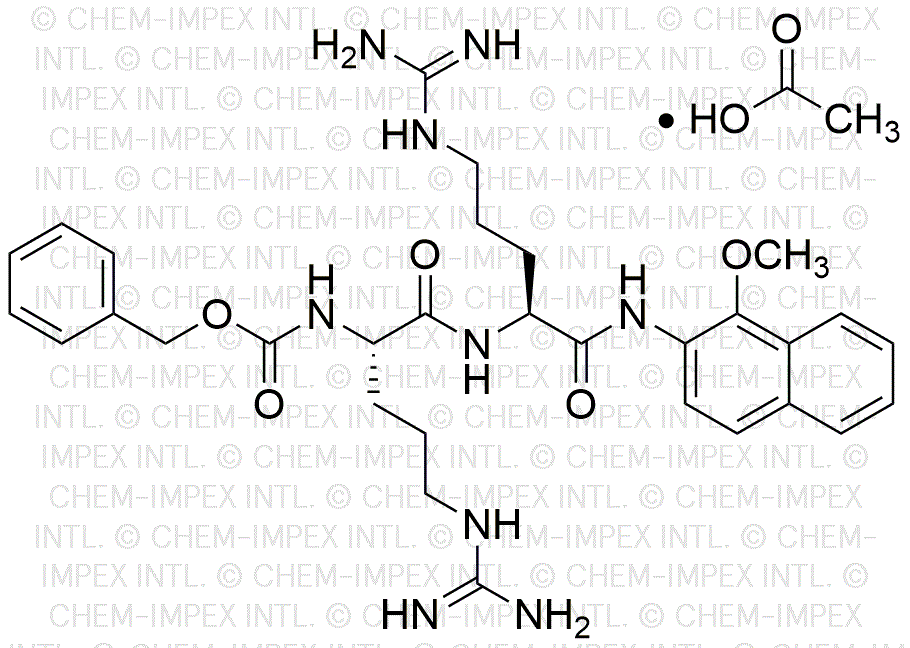Z-Arg-Arg-4MbNA acetate salt is widely utilized in research focused on:
- Peptide Synthesis: This compound serves as a key building block in the synthesis of peptides, particularly in the development of therapeutic agents and research tools in biochemistry and molecular biology.
- Drug Development: It plays a significant role in the design of peptide-based drugs, providing researchers with a versatile option for creating targeted therapies in fields like oncology and immunology.
- Bioconjugation: The compound is used in bioconjugation processes, allowing for the attachment of biomolecules to drugs or imaging agents, enhancing their effectiveness in medical diagnostics and treatment.
- Research on Protein Interactions: It aids in studying protein-protein interactions, which is crucial for understanding cellular mechanisms and developing new therapeutic strategies.
- Diagnostic Applications: The compound is explored for use in diagnostic assays, particularly in detecting specific biomarkers, thus improving early disease detection and monitoring.
General Information
Properties
Safety and Regulations
Applications
Z-Arg-Arg-4MbNA acetate salt is widely utilized in research focused on:
- Peptide Synthesis: This compound serves as a key building block in the synthesis of peptides, particularly in the development of therapeutic agents and research tools in biochemistry and molecular biology.
- Drug Development: It plays a significant role in the design of peptide-based drugs, providing researchers with a versatile option for creating targeted therapies in fields like oncology and immunology.
- Bioconjugation: The compound is used in bioconjugation processes, allowing for the attachment of biomolecules to drugs or imaging agents, enhancing their effectiveness in medical diagnostics and treatment.
- Research on Protein Interactions: It aids in studying protein-protein interactions, which is crucial for understanding cellular mechanisms and developing new therapeutic strategies.
- Diagnostic Applications: The compound is explored for use in diagnostic assays, particularly in detecting specific biomarkers, thus improving early disease detection and monitoring.
Documents
Safety Data Sheets (SDS)
The SDS provides comprehensive safety information on handling, storage, and disposal of the product.
Product Specification (PS)
The PS provides a comprehensive breakdown of the product’s properties, including chemical composition, physical state, purity, and storage requirements. It also details acceptable quality ranges and the product's intended applications.
Certificates of Analysis (COA)
Search for Certificates of Analysis (COA) by entering the products Lot Number. Lot and Batch Numbers can be found on a product’s label following the words ‘Lot’ or ‘Batch’.
Numéro de catalogue
Numéro de lot/série
Certificates Of Origin (COO)
This COO confirms the country where the product was manufactured, and also details the materials and components used in it and whether it is derived from natural, synthetic, or other specific sources. This certificate may be required for customs, trade, and regulatory compliance.
Numéro de catalogue
Numéro de lot/série
Safety Data Sheets (SDS)
The SDS provides comprehensive safety information on handling, storage, and disposal of the product.
DownloadProduct Specification (PS)
The PS provides a comprehensive breakdown of the product’s properties, including chemical composition, physical state, purity, and storage requirements. It also details acceptable quality ranges and the product's intended applications.
DownloadCertificates of Analysis (COA)
Search for Certificates of Analysis (COA) by entering the products Lot Number. Lot and Batch Numbers can be found on a product’s label following the words ‘Lot’ or ‘Batch’.
Numéro de catalogue
Numéro de lot/série
Certificates Of Origin (COO)
This COO confirms the country where the product was manufactured, and also details the materials and components used in it and whether it is derived from natural, synthetic, or other specific sources. This certificate may be required for customs, trade, and regulatory compliance.


